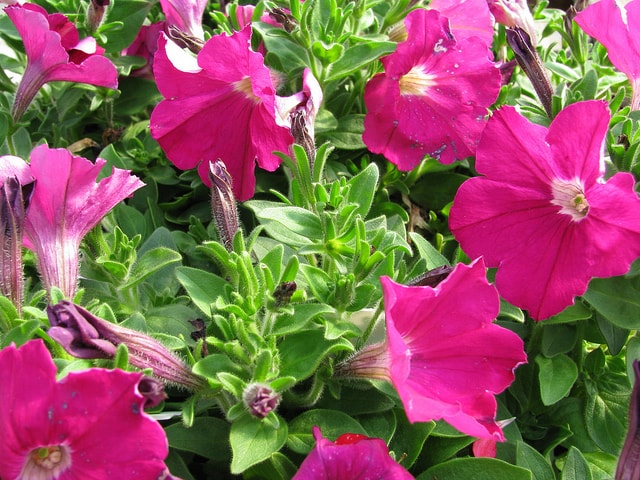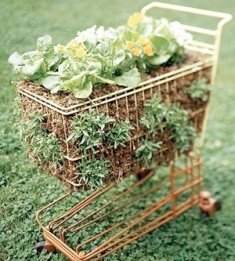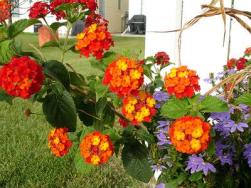Dictionary of Flowers: Petunia
One of dozens of beautiful Petunia species. Image used under a Creative Commons licence with the kind permission of Serres Fortier and Flickr
- Petunia
- Common name: petunia
- Family: Solanaceae
- Category: annual
- Height: 12" and up
- Width: 12" to 36”
- Sun
- Blooms: midsummer to fall, even earlier if purchased as starts
- Attracts: hummingbirds
- Growth habit: upright, trailing. Used as a filler or spiller in container combinations
- Maintenance: easy
- Soil: fertile, well drained. Water regularly if grown in containers
- Garden uses: containers, hanging basket, mixed border, bedding plant, edging
- Diseases: generally disease resistant, rot in humid climates
- Pests: aphids
Petunia is probably the most widely used annual for containers and hanging baskets. There are about seventy species of petunias, from which the forms used in the garden nowadays have been hybridized.
Though they have different growth habits, depending on cultivar, all of them have trumpet shaped flowers in colors that range between white, yellow, pinks, red, shades of purple or bicolors.
The blooms can be double or single, with ruffled edges and size of flowers depends on cultivar.
There are three main hybrid groups, the 'Wave', a groundcover type that trails, multiflora, and milliflora which bear the smallest flowers and grandiflora and floribunda types, with large blooms.
Petunia leaves are small, green, fuzzy and sticky. Some petunia varieties are scented.
Petunia prefers full sun to part sun and fertile soil whether grown in the garden or in containers. They require constant moisture to bloom well in containers (might need to be watered twice a day when days are hot and dry), and they are heavy feeders.
When first planting petunia, either amend the soil with plenty of organic matter or till in a slow release granular fertilizer.
Feed bi-weekly during summer with a bloom boosting fertilizing formula to keep them blooming during the summer and into fall.
In midsummer petunia can get leggy. Trim back by about a third and continue watering and feeding them regularly.
They will resume blooming. They need to be deadheaded to prevent seed formation and to keep the plants tidy.
IWILLWRITECAPTION. Image used under a Creative Commons licence with the kind permission of NAMEOFFLICKRUSER and Flickr
Petunias are easily available in nurseries during spring and summer months. If starting from seed, about six to eight weeks before last frost date, sprinkle seed into moist starting medium and do not cover. Cover with clear plastic and keep very warm at about 80F.
Petunia takes up to two weeks to germinate. When seed has germinated, move to a bright location with cooler temperatures. Transplant to individual containers when they have two or three sets of true leaves.
They need to start getting fertilized then with a diluted balanced liquid fertilizer (half the recommended ratio) bi-weekly. Harden off and plant in their permanent spot in the garden once all danger of frost has passed.
They can also be propagated by cuttings. Clip cuttings with three pairs of leaves, remove the bottom pair and dip into rooting powder.
Insert cuttings into moist potting soil and keep humidity high by covering them with plastic if needed. Never allow them to dry completely. They should start forming roots in two to three weeks.
IWILLWRITECAPTION. Image used under a Creative Commons licence with the kind permission of NAMEOFFLICKRUSER and Flickr
Petunia is free from disease if grown in appropriate conditions. Too much humidity or lack of proper drainage can lead to rot.
Aphids and budworms can become a problem. Treat with insecticidal soap when needed.
Popular varieties:
- Spreading petunia (hedgiflora) -shortest of all the varieties (grows up to six inches tall), but spreads up to four feet. The 'Wave' series are the most recognizable in this category. 'Surfinia' is another series with good tolerance to heat, humidity and rain.
- Milliflora petunia - smallest blooms in the petunia genus, but they perform well in most weather conditions. Blooms are about one to one and a half inches diameter. Cultivars in this category include 'Supertunia', 'Picobella' and 'Fantasy' series.
- Multiflora petunias - larger blooms than milliflora and better weather resistance than grandiflora. 'Carpet' or 'Madness' series are easily available, whether growing from seed or starts.
- Grandiflora petunia - this group has the largest bloom size, up to four inches. Single and double varieties. However, they don't handle rainy conditions well. 'Prism' series is very early blooming, 'Ultra' is compact and low spreading with ruffled blooms. 'Supercascade' is well suited for containers and hanging baskets. 'EZ Rider' is well suited for cold climates.
IWILLWRITECAPTION. Image used under a Creative Commons licence with the kind permission of NAMEOFFLICKRUSER and Flickr
Full List of Dictionary of Flowers Entries
Annuals For Containers |






